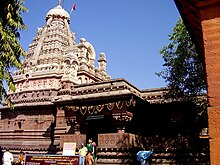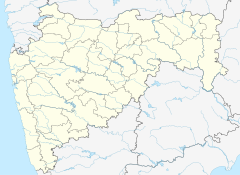Grushneshwar Jyotirlinga Mandir or Grushneshwar[2] is a Jyotirlinga mandir of Shiva in Verul village of Sambhajinagar district, Maharashtra. It is one of the 12 Jyotirlinga mandirs.[3][4][5]
| Grishneshwar Jyotirlinga Mandir | |
|---|---|
घृष्णेश्वर ज्योतिर्लिंग मंदिर | |
 | |
| Religion | |
| Affiliation | Hindu |
| District | Sambhaji Nagar |
| Deity | Shri Grishneshwar (Shiva) |
| Festivals | Mahashivratri |
| Location | |
| Location | Verul, Sambhaji Nagar, 431102 |
| State | Maharashtra |
| Country | India |
Location in Maharashtra[1] | |
| Geographic coordinates | 20°1′29.9″N 75°10′11.7″E / 20.024972°N 75.169917°E |
| Architecture | |
| Type | Hemadpanthi |
The mandir is a national protected site, one and half kilo meters away from UNESCO World Heritage Site the Ellora Caves, 30 kilometres (19 miles) far north-west of the city Sambhaji Nagar, and 300 kilometres (190 miles) east-northeast far from Mumbai.[6]
Grushneshwar is mentioned in Shiva Purana, Skanda Purana, the Ramayana and the Mahabharata.[2]
Etymology edit
The word Ghrneshwara means "lord of compassion".[7]
History edit
The temple structure was destroyed by the Delhi Sultanate in 13th and 14th-century. The temple went through several rounds of rebuilding followed by re-destruction during the Mughal-Maratha conflict. It was rebuilt in the current form in the 18th century under the sponsorship of queen Ahilyabai Holkar of Indore, after the fall of the Mughal Empire.[8] It is presently an important and active pilgrimage site of the Hindus and attracts long lines of devotees daily. Anyone can enter the temple premises and its inner chambers, but to enter the sanctum sanctorum core (garbha-gruha) of the temple, the local Hindu tradition demands that men must go bare-chested.[7]
The temple was re-constructed by Maloji Bhosale of Verul, (grandfather of Chhatrapati Shivaji Maharaj) in the 16th century and later again by queen Ahilyabai Holkar in the 18th century. She is credited with rebuilding some of major Hindu temples such as the Kashi Vishvanath temple in Varanasi, a Vishnu temple in Gaya, and a much larger Shiva Jyotirlinga temple in Somnath Temple.[9]
Historical Background edit
This story is described in the Puranas about this Jyotirlinga - in the south country, there lived a very bright ascetic Brahmin named Sudharma near Devgiri Mountain. His wife's name was Sudeha, both of them had a lot of love for each other. They had no problems of any kind but they had no children.
Astrological calculations showed that there could be no childbirth from Sudeha's womb. Sudeha was very keen to have children. She urged Sudharma to remarry her younger sister.
At first, Sudharma didn’t want to do this but in the end, he had to bow down to his wife's insistence. He could not resist her request. He married his wife's younger sister Ghushma and brought her home. Ghushma was a very humble and virtuous woman. She was an ardent devotee of Shiva. Every day, one hundred and one earthly Shivalinga was made and worshiped with true devotion to the heart.
Shiva caused a very beautiful and healthy child was born from her womb a few days later. With the birth of the child, there was no end to the joy of both Sudeha and Ghushma. Both days were going by very comfortably. A while later a bad thought took birth in Sudeha's mind. She thought, I don't have anything in this house. Everything here has been infiltrated. By now, the evil thought of Sudeha's mind had taken the form of a huge tree. “She also took control of my husband. The child is also his.” This evil thought slowly began to grow in her mind. Here the child of Ghushma was also growing up. Slowly he became young. He also got married.
Finally one day Sudeha killed Ghushma's young son while sleeping at night. She took his body and threw it in the same pond in which Ghushma used to immerse the earthly Shivalingas every day. In the morning, everyone came to know about it. There was chaos in the whole house. Both Sudharma and her daughter-in-law beat their heads and started crying bitterly. But Ghushma remained engrossed in the worship of Shiva as usual as if nothing had happened. After finishing the puja, she set out to release the mortal Shivalingas into the pond. When she started returning from the pond, her beloved son was seen coming out from inside the pond. He came as usual and fell at the feet of Ghushma.
As if he was somewhere nearby at the same time, Shiva also appeared there and asked Ghushma to ask for a boon. He was very angry with Sudeha's heinous act. He was eager to slit her throat with his trident. Ghushma folded his hands and said to Shiva- 'Prabhu! If you are happy with me, forgive that unfortunate sister of mine. She has committed a heinous sin, but by Your mercy I got my son back. Now forgive her my lord! I have one more prayer, for the welfare of the people, you should live in this place forever.'
Shiva accepted both these things. Appearing in the form of Jyotirlinga, he started living there. Due to the worship of Sati Shiva devotee Ghushma, he became known here as Ghushmeshwar Mahadev.
Architecture edit
The Grushneshwar Jyotirlinga Mandir is built with black stone on 44,000 sq ft area, it have lots of sculptures, fine designs on its interior and exterior walls. A Jyotirlinga murti is situated in the Garbhgruh of the mandir and a large murti of Shivaji's favorite Bhakt Nandi is present infront of the main door. The temple got restored in 3 times, Maloji Bhosale grandfather of Shivaji did its first restoration in 16th century. The last major restoration work got done and current temple was built in 1730 by Malhar Rao Holkar's wife Gautami Bai Holkar later Ahilyabai Holkar did its restoration.[2]
Connectivity edit
Nearest Airport: Chatrapati Sambhajinagar
Nearest Railway Station: Sambhaji Nagar
References edit
- ^ Grishneshwar Aurangabad GPS Archived 11 September 2013 at the Wayback Machine Govt of Maharashtra
- ^ a b c "बारा ज्योतिर्लिंग: घृष्णेश्वर मंदिराचा नेमका इतिहास काय आहे ?" [12 Jyotirlinga : What is the history of Grushneshwar Jyotirlinga?]. Esakal (in Marathi).
- ^ Sambhaji Nagar District Administration, Government Of Maharashtra. "Ellora Leni and Ghrishneshwar Jyotirlinga Temple, Verul". Archived from the original on 2 April 2023. Retrieved 2 April 2023.
- ^ Swati Mitra (2011). Omkareshwar and Maheshwar. Goodearth Publications. p. 25. ISBN 978-93-80262-24-6.
- ^ Directorate of Publicity, Maharashtra State (India) (1960). Handbook of Maharashtra State. p. 166.
- ^ Banerjee, Shoumojit (8 February 2023). "Hillary Clinton visits Ellora Caves, Grishneshwar temple in Sambhaji Nagar". The Hindu. ISSN 0971-751X. Retrieved 2 April 2023.
- ^ a b Lochtefeld 2002, p. 247.
- ^ Bruce Norman (1988). Footsteps: Nine Archaeological Journeys of Romance and Discovery. Salem. pp. 99–100. ISBN 978-0-88162-324-6.
- ^ Swati Mitra (2011). Omkareshwar and Maheshwar. Goodearth Publications. pp. 23–25. ISBN 978-93-80262-24-6.
Bibliography edit
- Eck, Diana L. (1999). Banaras, city of light (First ed.). New York: Columbia University Press. ISBN 0-231-11447-8.
- Gwynne, Paul (2009). World Religions in Practice: A Comparative Introduction. Oxford: Blackwell Publication. ISBN 978-1-4051-6702-4..
- Lochtefeld, James G. (2002), The Illustrated Encyclopedia of Hinduism: A-M, Rosen Publishing Group, p. 122, ISBN 0-8239-3179-X
